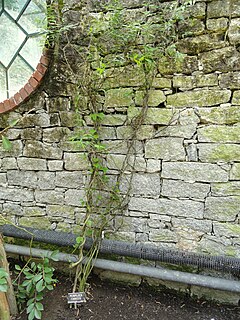
Luma apiculata, the Chilean myrtle, is a species of flowering plant in the myrtle family, native to the central Andes between Chile and Argentina, at 33 to 45° south latitude. Growing to 10–15 m (33–49 ft) tall and wide, it is a vigorous, bushy, evergreen tree with fragrant flowers.

Rhizophora is a genus of tropical mangrove trees, sometimes collectively called true mangroves. The most notable species is the red mangrove but some other species and a few natural hybrids are known. Rhizophora species generally live in intertidal zones which are inundated daily by the ocean. They exhibit a number of adaptations to this environment, including -pneutomatophores that elevate the plants above the water and allow them to respire oxygen even while their lower roots are submerged, and a cytological molecular "pump" mechanism that allows them to remove excess salts from their cells. The generic name is derived from the Greek words ριζα (rhiza), meaning "root," and φορος (phoros), meaning "bearing," referring to the stilt-roots.
Rupicola is a small genus of flowering plants in the family Ericaceae. The species are endemic to New South Wales in Australia and include:
Cyathea apiculata is a species of tree fern native to Sumatra, where it grows in montane rain forest at an altitude of about 1800 m. The trunk is erect and usually 5 m tall or more. Fronds are bi- or tripinnate and 2–3 m long. The stipe is pale, becoming darker towards the base. It is covered with dark scales with pale, fragile edges. Sori occur near the midvein of fertile pinnules and are covered by thin, very fragile indusia.
Syringogaster is a genus of small ant-mimicking flies with a petiolate abdomen, a long prothorax, a swollen and spiny hind femur, and reduced head size and large eyes. There are 20 described extant species and two species known from Miocene amber from the Dominican Republic. It is the only genus in the family Syringogastridae.
Endodonta apiculata is a species of small air-breathing land snail, a terrestrial pulmonate gastropod mollusc in the family Endodontidae, an endemic family of land snails from the Hawaiian islands.

Rhizophora apiculata is a species of plant in the Rhizophoraceae family. It is found in Australia, Guam, India, Indonesia, Malaysia, Micronesia, New Caledonia, Papua New Guinea, the Philippines, Singapore, the Solomon Islands, Sri Lanka, Taiwan, the Maldives, Thailand, Vanuatu, and Vietnam.
Schefflera apiculata is a species of plant in the family Araliaceae. It is endemic to the Maluku Islands in Indonesia.
Spirotecoma apiculata is a species of plant in the Bignoniaceae family. It is endemic to Cuba. It is threatened by habitat loss.

Fisetinidin is an anthocyanidin. It has been obtained from the heartwood of Acacia mearnsii, from the bark of Rhizophora apiculata and can also be synthesized.

Diplolepis is a plant genus in the family Apocynaceae, first described as a genus in 1810. It is native to southern South America.
- Diplolepis boerhaviifolia - Chile
- Diplolepis descolei - Argentina
- Diplolepis geminiflora - Chile
- Diplolepis hieronymi - Argentina
- Diplolepis menziesii - Chile
- Diplolepis nummulariifolia - Chile
- D. apiculata, syn of Tylophora hirsuta
- D. longirostrum, syn of Cynanchum longirostrum
- D. ovata, syn of Tylophora ovata
- D. variabilis, syn of Cynanchum atacamense
- D. vomitoria, syn of Tylophora asthmatica

Periploca is a genus of plants in the Apocynaceae family, first described for modern science by Linnaeus in 1753. It is native to Europe, Asia, and Africa.
- Periploca aphyllaDecne. - Middle East from Sinai to Pakistan
- Periploca calophylla(Wight) Falc. - S China, Nepal, Bhutan, Assam, E Himalayas, Vietnam
- Periploca chevalieriBrowicz - Cape Verde Islands
- Periploca chrysanthaD.S. Yao, X.D. Chen & J.W. Ren - Gansu Province in China
- Periploca floribundaTsiang - Yunnan, Vietnam
- Periploca forrestiiSchltr. - Guangxi, Guizhou, Qinghai, Sichuan, Tibet, Yunnan, India, Kashmir, Myanmar, Nepal
- Periploca graecaL. - Mediterranean
- Periploca hydaspidisFalc. - Kashmir
- Periploca laevigataAiton - Canary Islands, Savage Islands
- Periploca linearifoliaQuart.-Dill. & A. Rich - Ethiopia
- Periploca nigrescensAfzel. - W Africa
- Periploca refractifoliaGilli - Tanzania
- Periploca sepiumBunge - widespread across much of China
- Periploca tsiangiiD. Fang & H.Z. Ling - Guangxi Province in China
- Periploca visciformis(Vatke) K. Schum. - Somalia

Eucalyptus apiculata, commonly known as the narrow-leaved mallee ash and is a mallee that is endemic to New South Wales. It has smooth white or greyish bark, narrow lance-shaped adult leaves, flower buds in groups of three to seven, white flowers and urn-shaped or barrel-shaped fruit.

Sclerodoris is a genus of sea slugs, specifically dorid nudibranchs. They are marine gastropod molluscs in the family Discodorididae.
Sclerodoris apiculata is a species of sea slug, a dorid nudibranch, shell-less marine opisthobranch gastropod mollusks in the family Discodorididae.

Pardalophora is a genus of band-winged grasshoppers in the family Acrididae. There are at least four described species in Pardalophora.

Pardalophora apiculata, known generally as the coral-winged grasshopper or coral-winged locust, is a species of band-winged grasshopper in the family Acrididae. It is found in North America.

Thelymitra apiculata, commonly called Cleopatra's needles, is a species of orchid in the family Orchidaceae and endemic to the south-west of Western Australia. It has a single erect, curved, dark green leaf with a purplish base and up to twelve purplish flowers with darker blotches and golden yellow edges. There are two yellow arms on the sides of the column, each ending with a needle-like point.

Hemilienardia apiculata is a species of sea snail, a marine gastropod mollusk in the family Raphitomidae.













